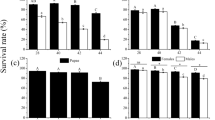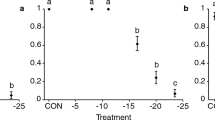Abstract
The cold hardiness of the broad mite, Polyphagotarsonemus latus, a key pest in Rhododendron simsii hybrid production in northwestern Europe, was investigated in the laboratory. Survival of eggs, larvae and female adults and reproduction capacity of female P. latus were evaluated following cold exposure at 7 °C. Adult females were also exposed to temperatures of 2 and −3 °C. Further, the supercooling point and lower lethal times of adult females were determined. No eggs survived exposure to 7 °C for 17 or more days. Larval survival upon the cold treatment decreased from 53 to 13 % when exposed to 7 °C for 14 and 49 days, respectively. Two-day-old adult females exposed to 7 °C for up to 42 days did not suffer significant mortality, but when returned to 25 °C their oviposition rates were lower than those of mites maintained at 25 °C. Less than 40 % of females exposed for 13 days to 2 °C survived; only 20 % of these females was able to reproduce upon recovery. Subzero temperatures dramatically decreased survival and reproduction capacity of adult females. The supercooling point of female adults was −16.5 °C. Median lethal times averaged 61.2 h and 9.3 days at −3 and 2 °C, respectively. In conclusion, a long term exposure (up to 6 weeks) of R. simsii plants infested with P. latus to a temperature of 7 °C, which is required for breaking dormancy of the flowers, is not expected to have detrimental effects on the survival and reproductive performance of the female mites.



Similar content being viewed by others
References
Abou-Awad BA, Hafez SM, Farhat BM (2014) Biological studies of the predacious mite Amblyseius swirskii, a predator of the broad mite Polyphagotarsonemus latus on pepper plants (Acari: Phytoseiidae: Tarsonemidae). Arch Plant Pathol Plant Protec 47(3):349–354
Allen CM (2010) Thermal biology and behaviour of two predatory Phytoseiid mites: Amblyseius swirskii (Athias-Henriot) (Acari:Phytoseiidae) and Phytoseiulus longipes (Evans) (Acari:Phytoseiidae). Ph.D. thesis, University of Birmingham
Bale JS (1987) Insect cold hardiness—freezing and supercooling—an ecophysiological perspective. J Insect Physiol 33(12):899–908
Bale JS (2002) Insects and low temperatures: from molecular biology to distribution and abundance. Philos Trans R Soc Lond B Biol Sci 357(1423):849–862
Bale JS, Jones TH, Gibbons D (1996) Impacts of climate change. J Zool 240:593–597
Christiaens A, De Keyser E, Lootens P, Pauwels E, Roldán-Ruiz I, De Riek J, Gobin B, Van Labeke M-C (2014) Cold storage to overcome dormancy affects the carbohydrate status and photosynthetic capacity of Rhododendron simsii. Plant Biology. doi:10.1111/pbl.12195
Denmark HA (1988) The cyclamen mite, Phytodromus pallidus (Banks) (Acari: Tarsonemidae). Ent Circ 306
Ferreira RCF, de Oliveira JV, Haji FNP, Gondim MG Jr (2006) Biologia, exigências térmicas e tabela de vida de fertilidade do ácaro-branco Polyphagotarsonemus latus (Banks) (Acari: Tarsonemidae) em videira (Vitis vinifera L.) cv. Itália. Neotrop Entomol 35:126–132
Gerson U (1992) Biology and control of the broad mite, Polyphagotarsonemus latus (Banks) (Acari: Tarsonemidae). Exp Appl Acarol 13:163–178
Hart AJ, Bale JS, Tullet AG, Worland MR, Walters KFA (2002) Effects of temperature on the establishment potential of the predatory mite Amblyseius californicus McGregor (Acari: Phyoseiidae) in the UK. J Insect Physiol 48:593–599
Heungens A (1986) Soft-skinned mites in azalea culture and comparable control results on other host plants. Verbondsnieuws voor de Belgische Sierteelt 30:257–269 (in Dutch)
Hoy M (2011) Agricultural acarology: introduction to integrated mite management. Chapter 7. The tarsonemidae. CRC Press, Boca Raton, pp 103–108
Jeppson LR, Keifer HH, Baker EW (1975) Mites injurious to economic plants. University of California Press, Berkeley, xxiv + 614 pp
Jones VP, Brown RD (1983) Reproductive responses of the broad mite Polyphagotarsonemus latus (Acari: Tarsonemidae), to constant temperature–humidity regimes. Ann Entomol Soc Am 76:466–469
Jovicich E, Cantliffe DJ, Osbore LS, Stoffella PJ, Simonne EH (2008) Release of Neoseiulus californicus on pepper transplants to protect greenhouse-grown crops from early broad mite (Polyphagotarsonemus latus) infestations. In: Mason PG, Gillespie DR, Vincent C (eds) Proceedings of the third international symposium on biological control of arthropods, Christchurch, New Zealand, pp 347–353
Karl E (1965) Untersuhungen zur Morphologie und Ökologie von Tarsonemiden gärtnerischer Kulturpflanzen. II Hemitarsonemus latus (Banks), Tarsonemus confusus Ewing, T. talpae Schaarschmidt, T. setifer Ewing, T. smithi Ewing und Tarsonemoides belemnitoides. Weis-Fogh Biol Zentralbl 84:331–357 (in German)
Labanowski G, Soika G (2006) Tarsonemid mites on ornamental plants in Poland: new data and an overview. Biol Lett 43:341–346
Li J, Yanyun Y, Yunfang Q, Qianhong W (2003) Experimental population life table of Amblyseius cucumeris Polyphagotarsonemus latus as prey. Acta Phytophylacica Sin 30(4):389–395 (in Chinese)
Li LS, Li YR, Bu GS (1985) The effect of temperature and humidity on the growth and development of the broad mite, Polyphagotarsonemus latus. Acta Entomol Sin 28:181–187 (in Chinese)
Luypaert G, Witters J, Van Huylenbroeck J, Maes M, De Riek J, De Clercq P (2014) Temperature-dependent development of the broad mite Polyphagotarsonemus latus (Acari: Tarsonemidae) on Rhododendron simsii. Exp Appl Acarol 6(3):389–400
McCullagh P, Nelder JA (1989) Generalized linear models. Chapman and Hall, New York, p 511
Morewood WD (1992) Cold hardiness of Phyoseiulus perisimilis Athias-Henriot and Amblyseius cucumeris (Oudemans) (Acarina: Phytoseiidae). Can Entomol 124(6):1015–1025
Navajas M, Migeon A, Estrada-Pena A, Mailleux AC, Servigne P, Petanovic R (2010) Chapter 7.4: The Acari. In: Roques A et al. (ed) Invasive terrestrial invertebrates in Europe. BioRisk (special issue) pp 149–192
Onzo A, Houedokoho AF, Hanna R (2012) Potential of the predatory mite, Amblyseius swirskii to suppress the broad mite, Polyphagotarsonemus latus, on the gboma eggplant, Solanum macrocarpon. J Insect Sci 12:7
Peña JE, Osborne L (1996) Biological control of Polyphagotarsonemus latus (Acarina: Tarsonemidae) in greenhouse and field trials using introductions of predacious mites (Acarina: Phytoseiidae). Entomophaga 41(2):279–285
Richardson E, Seeley S, Walker D (1974) A model for estimating the completion of rest for Redhaven Elberta peach trees. HortScience 9:331–332
Smith LM, Goldsmith EV (1936) The cyclamen mite, Tarsonemus pallidus, and its control on field strawberries. Hilgardia 10(3):53–94
Stuart NW (1965) Groth retardants, storage temperature and length of storage for controlling the flowering of greenhouse azaleas. Flor Rev 136:14–15
van Maanen R, Vila E, Sabelis MW, Janssen A (2010) Biological control of broad mites (Polyphagotarsonemus latus) with the generalist predator Amblyseius swirskii. Exp Appl Acarol 52:29–34
Vincent CI, García ME, Johnson DT, Rom CR (2010) Broad mite on primocane-fruiting blackberry in organic production in Arkansas. HortTechnol 20(4):718–723
Waterhouse DF, Norris KR (1987) Biological control: Pacific prospects. Inkata Press, Melbourne
Weintraub PG, Kleitman S, Mori R, Shapira N, Palevsky E (2003) Control of the broad mite (Polyphagotarsonemus latus (Banks)) on organic greenhouse sweet peppers (Capsicum annuum L.) with the predatory mite, Neoseiulus cucumeris (Oudemans). Biol Control 27:300–309
Wiesmann R (1941) Investigations on the biology and control of the strawberry mite, Tarsonemus pallidus (fragariae Z.) Banks. Landwirtschaftliches Jahrbuch der Schweiz 55(3):259–329
Acknowledgments
The authors wish to thank the ILVO greenhouse technicians for excellent plant cultivation and Magali Losschaert for outstanding technical assistance during the experiments. This research was funded by the Institute for the Promotion of Innovation through Science and Technology in Flanders (IWT-Vlaanderen Grant No. 100859).
Author information
Authors and Affiliations
Corresponding author
Rights and permissions
About this article
Cite this article
Luypaert, G., Witters, J., Berkvens, N. et al. Cold hardiness of the broad mite Polyphagotarsonemus latus (Acari: Tarsonemidae). Exp Appl Acarol 66, 29–39 (2015). https://doi.org/10.1007/s10493-015-9894-3
Received:
Accepted:
Published:
Issue Date:
DOI: https://doi.org/10.1007/s10493-015-9894-3




